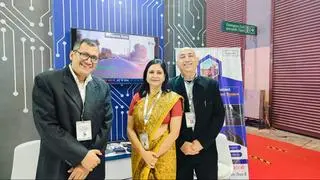For Srinath Ravichandran, co-founder and CEO, Agnikul Cosmos Pvt Ltd, it has been an interesting journey. He worked for a couple of years after completing his engineering Bachelor’s and he says he did what most of his peers did – switched over to the financial services industry.
The financial engineering programme he studied at Columbia University was about using advanced mathematics to figure stock market trends. “I was fascinated by the course, but the only thing was I got the timing perfectly wrong,” says Srinath. He was in New York in 2008, at a time when the financial industry globally went into a tailspin because of the crash of Lehman Brothers. He got into portfolio management in a hedging firm, but then realised that was not his cup of tea. He also figured out that his childhood passion was aerospace.
He did a lot of preparatory work, registered for a Master’s programme – his second – in aerospace engineering and moved to the West Coast, to Los Angeles, because the aerospace industry is concentrated in that area, he says. When he signed up for the aerospace engineering programme, his aim was not to turn an entrepreneur, but soon realised that being an entrepreneur was easier than getting a job in the aerospace industry in the US. He started looking for opportunities, got in touch with people through friends and contacts. That is how he got in touch with Satyanarayanan Chakravarthy, an IIT-Madras faculty, and his other co-founder Moin SPM.
“Once Chakravarthy came on board things started moving really fast,” says Srinath. Their idea was taking shape and they got admitted for incubation at IIT-M Incubation Cell. By this time, Srinath had also moved back to India. And, he says, when they got RV Perumal, a former senior ISRO official, on board, their idea began to take concrete shape. Perumal helped them map out various steps and put the venture on the correct path, according to Srinath.
The turning point
According to him, it was during his stay in Los Angeles that the idea for a venture like Agnikul was triggered. There, he says, people were keen on opening space access to everyone and providing a platform that made going to space easy for anyone who wanted to do so. “If you wanted to do something in space, getting there should not be the difficult part. That was the core motivation behind this,” he says. He also says that the space community in Los Angeles held the Indian space research community in high regard, which convinced Srinath that he had to be in India to build his venture.
“The reviews we have with ISRO, the continuing advice we get from ex-ISRO people, this is what is propelling us. We are not trying to re-invent the wheel. There are people who have built rockets. We are trying to package the physics that has always worked with the manufacturing and the electronics of the 21st century. That marriage is what I think is important to be a lean start-up in this space,” says Srinath.
With Perumal’s help, Agnikul was able to freeze the rocket’s configuration. “We 99 per cent know what the rocket itself should look like,” says Srinath. Being in the NCCRD, they have started working on the rocket engine, while simultaneously work is progressing on various other fronts – structures, sub-systems, electronics, guidance and navigation.
Building a rocket from the scratch is at least a five-year journey, says Srinath, of which the first 3-4 years are about figuring out the R&D and freezing the design and other configurations. Then comes executing it for space standards, manufacturing the rocket and actually launching it. The venture will meet the R&D expenses with the seed fund it raised and with the funds put in by Srinath and Moin. The next round of fund-raise will be used to take the company to the next level, increasing the team size from 35 now to almost 100 by the time of the rocket’s scheduled launch in 2021.

Huge market potential
According to Srinath, the market for rockets that can launch smaller satellites and at lower orbits is really huge. There are newer applications coming up for such types of satellites – storing data in space, protein crystallisation in space are just a couple. Traditionally, the larger satellites were used for communication or remote sensing. Some of the companies that were so far relying on bigger satellites are thinking of having a cluster – or, a constellation – of small satellites.
There are a handful of global companies that are working on rockets that will launch smaller satellites, which have raised a lot of private investor money. But, says Srinath, Agnikul’s strength will be its capability to launch these rockets at a fraction of the cost with robust technology. Agnikul, he adds, will complement ISRO and come up with rockets and technology that are not ISRO’s focus areas now.
According to him, Agnikul is part of Airbus’ accelerator programme, which too will help the company tap global expertise, especially since Airbus is a major stakeholder in Arianespace. If the venture meets some criteria, it will be eligible for €40,000 funding from the accelerator.
Srinath says Agnikul will manufacture the rocket and help launch the satellites for its customers. It is looking to partner with other academic institutions to help it manufacture the rockets. As it is, most of the rocket can be built at the IIT-M.








Comments
Comments have to be in English, and in full sentences. They cannot be abusive or personal. Please abide by our community guidelines for posting your comments.
We have migrated to a new commenting platform. If you are already a registered user of TheHindu Businessline and logged in, you may continue to engage with our articles. If you do not have an account please register and login to post comments. Users can access their older comments by logging into their accounts on Vuukle.